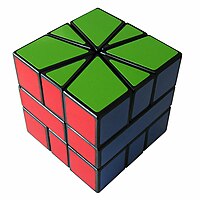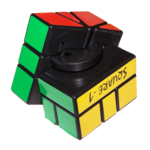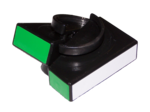Back to Square One
The Back to Square One (also Square One or Cube 21 ) is a cube-shaped patience game . Due to the way it is put together, it changes its shape through twisting and is then no longer cube-shaped. The aim of the game is to bring the game back from any shape to the cube-shaped state and to sort all the colors into the correct positions.
history
The Square One was invented around 1990 by Karel Hršel and Vojtěch Kopský. They filed their patent for the puzzle on November 8, 1990.
The name probably comes from the English expression "Back to Square One", which means something like "Back to the beginning". Since the cube was initially sold twisted, the name was quite appropriate.
construction
The Square One, made up of three layers, has an amazingly simple structure. The upper and lower layers each consist of four prisms with an isosceles triangle as a base - the edge stones - and four deltoid prisms - the corner stones. The middle layer consists of two trapezoidal prisms that together form a square prism. The corner and edge stones can simply be hooked into the 2 rails of the middle layer. As soon as there is no stone above the border of the 2 middle stones, but also a gap between 2 stones, you can turn the left or right side by 180 °. You can also rotate the pages by less or more than 180 °, but then you cannot rotate the top, middle or bottom layer afterwards. So from the position of the Square One in the first picture of this article, no horizontal plane can be rotated.
The mechanics make it possible to turn the game of patience in any direction the parts allow. This structure and the mechanics make it possible for the cube to change shape and no longer be cube-shaped.
In addition, each side has its own color when released, similar to the Rubik's Cube .
solutions
There are various possible solutions for the Square One. One is to first make the puzzle into a cube and then sort it in the correct color. Another approach is the layer-by-layer method, in which all layers are converted into the dissolved state from top to bottom.
The problem with solving the Square One is that algorithms may not be executable in a state of the puzzle game, since the possible rotation axes change due to the rotations.
Since the Square One is also solved in official speed cubing competitions - officially, that is, organized by the World Cube Association , WCA for short - there is also an official world record, this is 4.95 seconds, set by Jackey Zheng near Brooklyn in 2019 .
Mathematical properties
Possible positions
Since the Square-1 has 8 curb stones and 8 corner stones, the angles at the tip of the curb stones are 30 ° each and that of the corner stones is 60 °, the Back to Square One can take on 170 different shapes if you ignore the middle level . This is due to the fact that each level (except the middle one) can consist of either 2, 3, 4, 5 or 6 corner stones. 1 corner stone is impossible, otherwise you would need 10 edges to get a total of 360 °. 7 or all 8 curb stones are also not possible, since with 6 corners and 0 edges the level is already "full". Now there is 1 possible position if the one level consists of 6 corner stones (all 6 corners next to each other). 3 positions with 5 corner stones, 10 positions each with 4 and 3 corner stones and 5 positions with one corner stone. The 170 positions can be calculated from the fact that if the first level has 6 corner stones, the third must logically have 2 corner stones, which means 1 × 5 = 5 positions. Now the first level can have 5 corner stones and the third level 3 corner stones and so on. That brings you to the bill
(1 × 5) + (3 × 10) + (10 × 10) + (10 × 3) + (5 × 1) = 170
But now there is also the middle level. This can have 2 positions (square and concave square). Therefore you have to multiply 170 by 2.
Since the corner and edge stones of the Square-1 are not all the same color, the 170 × 2 must be 2 times with 8 ! multiply. This results in 170 × 2 × 8! × 8! = 552,738,816,000 positions.
However, this is only a preliminary result, as some of these positions, which have been assessed individually here, are the same. Therefore you have to subtract these positions again and arrive at the final result of 435,891,456,000 possible positions or, in other words: exactly 15! ÷ 3
God's algorithm
In 2005 Mike Masonjones calculated God's algorithm , i.e. the minimum number of moves that are required to solve the puzzle from every possible situation, for the Square One. As with other Rubik's Cube, this number of moves could only be mastered using brute force , so the shortest solution was determined individually for each position. Because of this applied method, a computer was used for the calculation. It had a clock frequency of 800 MHz and took about a year. The result was that each position can be solved with a maximum of 13 moves (see table), even only 12 if you do not take the middle level into account.
| God's algorithm of Square-1 | |
|---|---|
| required trains |
Positions |
| 0 | 1 |
| 1 | 64 |
| 2 | 1,153 |
| 3 | 17,050 |
| 4th | 235.144 |
| 5 | 3,091,458 |
| 6th | 38.893.230 |
| 7th | 452.031.138 |
| 8th | 4,459,167,504 |
| 9 | 33,671,064,770 |
| 10 | 149.502.310.936 |
| 11 | 183,662,070,768 |
| 12 | 6.394.5120.032 |
| 13 | 157.452.752 |
| total | 435,891,456,000 |
Web links
Individual evidence
- ^ List of Square-1 single world records on the World Cube Association website
- ↑ https://www.jaapsch.net/puzzles/square1.htm#numpos





